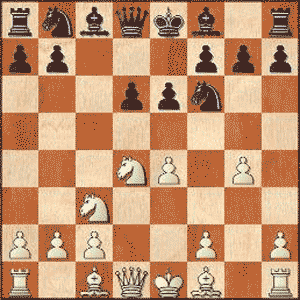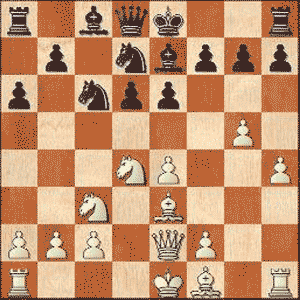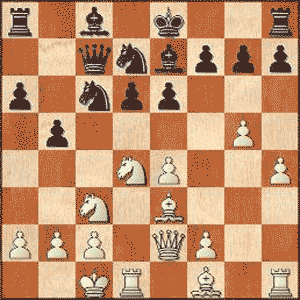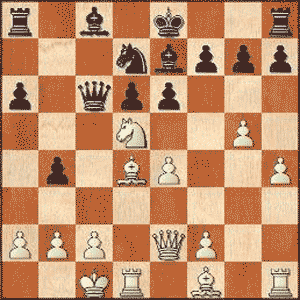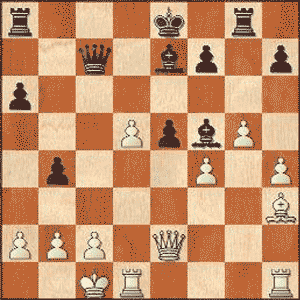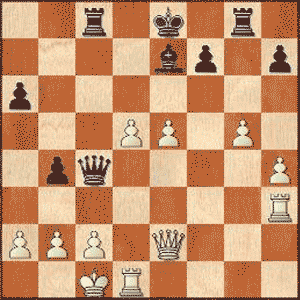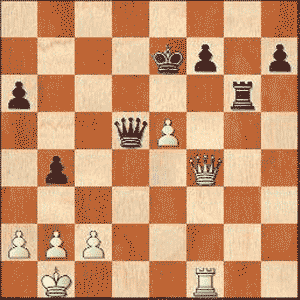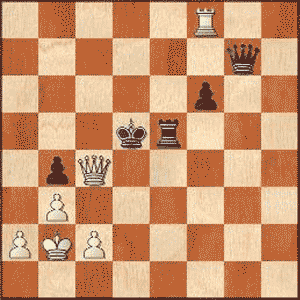| Back to Back Issues Page |
 |
|
LCB, Issue #088 --, A Rolling Pawn Mass Beats a Piece October 01, 2022 |
A Rolling Pawn Mass Beats a PieceLapoc Chess Board, Issue #088 -- GOTM #58 learn and play online chess I want to talk about something that is sometimes called a sacrifice but in this game can be better described as an exchange. In this month's game we see a minor piece exchanged for three pawns. Every exchange should be evaluated beforehand especially ones involving different kinds of material. In this case, are the extra pawns connected, advanced, dangerous? Is your King safe or vulnerable to your opponent's pieces (he's got one extra)? The game took place in Moscow in 1976 between Russian World Champion Anatoly Karpov and Josif Dorfman of France. The above scenario played out and led to a really interesting game. A Rolling Pawn Mass Beats a PieceKarpov, Anatoly - Dorfman, Josif [B81]GotM #58 - Moscow, 1976 [Connaughton, Ken] 1.e4 c5 Sicilian Defense 2.Nf3 Open Sicilian 2...d6 3.d4 cxd4 4.Nxd4 Nf6 5.Nc3 e6 6.g4
Keres Attack - Karpov: In those cases when it is necessary to win without fail, I turn to this sharp variation of the unforgettable Paul Petrovich Keres. And indeed, here I was meeting one of the leaders of the tournament... 6...Be7 7.g5 Nfd7 8.h4 The main theme of the Keres Attack is to launch a rapid attack against the Black Kingside. He will try to castle Kingside to give security to his own King. 8...Nc6 9.Be3 a6 10.Qe2!
Karpov: Stronger, and at any rate more interesting, than 10.Qd2, after which a Black Knight, arriving at e5, constantly threatens to leap to f3 or c4 (admittedly, after Be2 these threatened squares are covered, but this is a quieter, more positional continuation). Instead now the Queen stands on the same file as the Black King, which creates the preconditions for the combinational thrusts Nc3–d5 or Nd4–f5. Although many pieces stand on the e-file they are, as a rule, quickly cleared. 10...Qc7 11.0-0-0 b5
Karpov: Black provokes the opponent into a sacrifice, seemingly not fearing
its consequences. However, no other method of piece development for him is apparent, since after castling he would immediately come under a pawn attack. Here I thought for a long time, deciding which form of the Knight sacrifice is best. 12.Nxc6 (Karpov: Tempting appears 12.Nf5 and, naturally, bad for Black is 12...exf5 on account of (But the intermediate 12...b4! leads to boundless complications - 13.Nd5 exd5 14.exd5 Nde5!) 13.Nd5 Qd8 14.exf5; It was also possible to wait ( 12.f4 ), in order that the opponent should himself forced me to give up a piece ( 12...b4 13.Nd5 ). All the same the most promising to me seemed to be the continuation chosen in the game.) 12...Qxc6 13.Bd4 b4
14...exd5 15.Bxg7 (15.exd5?? Qxd5 16.Bxg7 Qxh1 17.Re1 Ne5 18.Bxe5 dxe5 19.Qxe5 0-0) 15...Rg8 16.exd5 Qc7 17.Bf6 Ne5 18.Bxe5 dxe5 19.f4 Bf5 20.Bh3?!
Dorfman considers the text move to be a mistake at what was, in his view, essentially the first critical moment of the game. (He (Dorfman) gives as correct the continuation 20.fxe5 Rf8 21.Rh2! analyzing no further than 21...Qa5 22.Qf3) 20...Bxh3 21.Rxh3 Rc8 22.fxe5 As the dust settles, White has three pawns for the piece. Black's King is also slightly vulnerable in front of those two dangerous pawns. 22...Qc4!
Karpov: This manoeuvre, organically linked with all of Black’s subsequent play, does honour to the resourcefulness of J. Dorfman (Translator’s note: Dorfman considers that after his mistake at the 20th move, it is already White who had to play resourcefully.) 23.Rdd3 Qf4+ 24.Kb1 Rc4 The position is very sharp. 25.d6 Re4 26.Rhe3 Rxe3 27.Rxe3 Qxh4 28.Qf3 Qxg5 29.Re1 Qg2 Black is happy to give the Bishop back in order to neutralize the threat from White's central pawns. He would emerge with the better endgame. 30.Qf5 Of course White declines and continues with a threat. 30...Rg6 31.Rf1 Both players know that the passed pawns are worth more than the Bishop. White changes the point of attack, targeting f7 now. 31...Qd5 Holding and building pressure on the pawns. White knows that Black will
soon cash in the Bishop so he must choose how the exchange goes down. 32.dxe7 Kxe7 33.Qf4!
Dorfman: This is the whole point – on account of the double threats of 34.Qh4+ and 34.Qxb4+ Black does not manage to construct a safe position after 33...Kf8. The remainder is a matter of straightforward technique, taking account of the fact that after the time control at the 40th move, the game was adjourned. 33...a5 White has a majority on the Queenside and is more advanced in the center. Black has a passer on the h-file. White is somewhat better but it's going to take some good chess playing for either player to win. 34.Qh4+ Ke8 35.Qxh7 There goes Black's passer. 35...Qf3 Black can't take the Queen but White finds a nice combination to bring his Queen around to support the Rook. 36.Qh8+ (36.Rxf3?? Rg1+ 37.Rf1 Rxf1#) 36...Ke7 37.Qh4+ Ke8 38.Qc4 Driving the Black Queen back to the second rank. 38...Qb7 39.b3 Air to breathe for the King will allow more activity for the Rook. 39...Re6 40.Rg1 White bids farewell to his e-pawn knowing he can eventually pick off some Black pawns in return. 40...Rxe5 41.Rg8+ Ke7 42.Qh4+ Kd7 43.Qf6 Re7 44.Qf5+ Kd6 45.Qxa5 Re5 46.Qd8+ Ke6 47.Kb2 After some fancy footwork, White has three pawns to one on the Queenside and Black's f-passer looks decidedly weak. 47...f6 48.Rf8 Qg7?? Of course this pawn is Black's only remaining source of counterplay and he does not want to lose
it, but this blunder is the final nail in the coffin. White will switch the focus of his attack now. 49.Qc8+ Kd5 50.Qc4+
Black resigns knowing nothing but more pain is coming. (After 50.Qc4+ if Black were to continue then 50...Kd6 51.Rd8+ with 51...Qd7 offering the longest but ultimately futile line of resistance. (51...Ke7 just loses quicker: 52.Qc7+ Ke6 53.Rd6+ Kf5 54.Qxg7 and so on.) ) 1-0 Karpov - Dorfman, Moscow, (1976) P.S. If you do not have html based email software and you're using a text only system, you may find that the links are only partially highlighted and may not work. If this is the case, simply copy and paste the entire link into the browser and hit Enter. That should get you where you want to go. Comments, ideas, feedback? I'd be stoked to hear from you. Get in touch See you next month. Ken 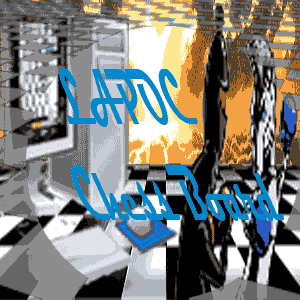
|
| Back to Back Issues Page |
